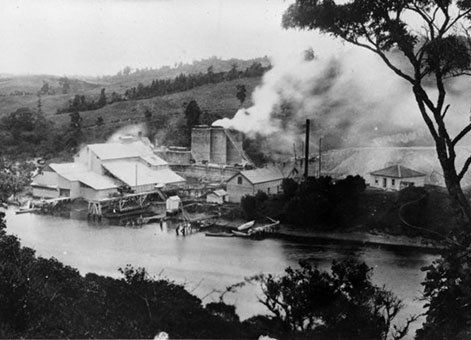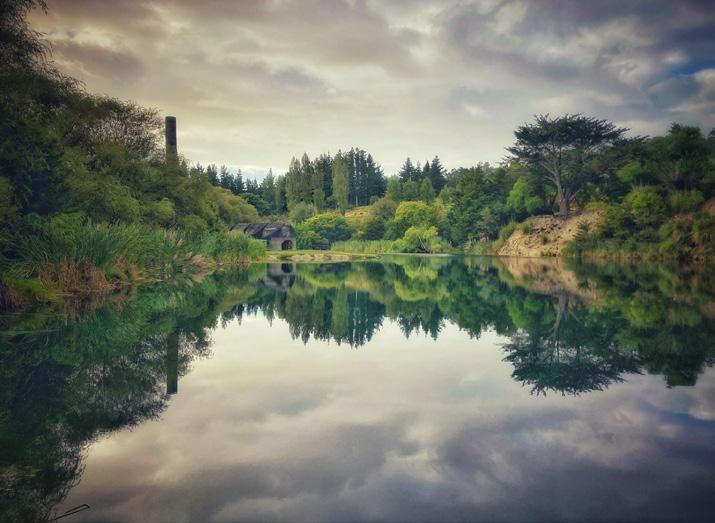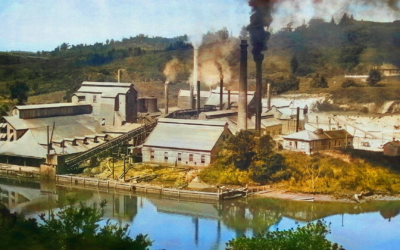A brief history of Wilson’s Cement Works
Warkworth is steeped in history, much of it anchored by the industrial might of Wilson’s Cement Works
The Warkworth Museum Exhibition
Warkworth Museum has an exhibition dedicated to Wilson’s Cement Works story. This fascinating collection traces the remarkable journey of Nathaniel Wilson and his cement empire. Visitors can follow the timeline from Nathaniel’s arrival in New Zealand as a child in 1842, his early years as a shoemaker to his pivotal role in developing Portland cement. Artifacts, photographs, and documents highlight the challenges and triumphs of the cement works.
In addition to historical artifacts, the exhibition includes recent photographs from a museum photo competition documenting the present state of the site. There is also a small display from the Cement Works Warkworth Conservation Trust, discussing the possible future of the cement works.

DIVE IN AND DISCOVER OUR MARINE WORLD
A Trio of Marine Marvels at Warkworth Museum A fascinating series of feature exhibitions are set to captivate visitors at Warkworth Museum from 29 May to 17 August 2025. Showcasing the wonders of marine life, two touring exhibitions from Te Papa Tongarewa, the Museum of New Zealand will feature...
WILSON CEMENT WORKS EXHIBITION
The Wilson Cement Works Exhibition tells the tale of one of New Zealand's early entrepreneurs who played a pivotal role in the production of Portland Cement in Warkworth.
TEXTILES, FROM OLD TO NEW
As part of the Mahurangi Artist Studio Trail 2024, we showcase heritage quilts, crochet and embroidery, together with more modern creations made by our talented volunteers. You will be mesmerized by the intricate details and artistry of the quilts, each telling a unique story. Our crochet and...
Wilson’s Cement Works: The founding and early years
Founded in the late 19th century, this cement factory was a cornerstone of local economic development and a testament to the innovative spirit of its founders. Today, the remnants of the cement works stand as silent witnesses to a bygone era, their storied past woven into the fabric of Warkworth’s community.
Wilson’s Cement Works was established in 1882 by Nathaniel Wilson who emigrated from Glasgow with his family when he was six years old. Nathaniel initially trained as a shoemaker but switched to lime production after seeing the potential in local limestone deposits. By 1885, Nathaniel and his brothers, John and James, began trading as J. Wilson and Company. Early production was challenging due to the variability of local limestone. Eventually, they overcame this by adding shells from the Mahurangi River and Clevedon to increase the lime content.
Technological innovations and expansion
As demand for cement grew, so did the need for more efficient production methods. The company continued to expand, incorporating advanced techniques and machinery. Wilson’s Cement Works was at the forefront of technological innovation. In 1903-4, the firm introduced American-made rotary kilns to produce cement more effectively, increasing annual production significantly. By 1910, the factory included several large mills and kilns and employed 180 workers.
Notable structures erected using Wilsons’ cement included Grafton Bridge in Auckland, which had the longest single concrete span in the world when built.
Decline and legacy
The mid-20th century saw a decline in local manufacturing as global economic shifts and increased competition took their toll. Despite efforts to modernise and adapt, Wilson’s Cement Works struggled to remain competitive. The factory closed its doors in 1929, marking the end of an era. Its passing was a severe blow to the town, where the livelihood of so many had come to depend on it.
Heritage New Zealand recognises Wilson’s Cement Works as a Category 1 historic place and the New Zealand Archaeological Association records it as an archaeological site. The ruins stand as a testament to the industry that once powered Warkworth’s economy and the people whose livelihoods depended upon its fortunes.
Modern use and community treasure
Today, the site of Wilson’s Cement Works is a place of historical reflection and modern recreation. The old cement works have become a beloved local treasure, especially during the summer months. The site is a popular picnic and swimming spot.
Flooded with fresh water, the area, provides an idyllic setting for family outings. According to Trip Advisor, “The Old Cement Works is such a lovely place to go to relax in the sun or take a dip in the water”. “It’s a hidden treasure in Warkworth”. “Nothing is quite as good for beating the heat as a swim, and the swimming spot at the Old Cement Works in Warkworth is far more than your average pool”.
Visitors can enjoy swimming in the lake, diving and bombing off the edges of the bank, or simply soaking up the sun.
“Bring the kids, bring your friends, bring your dog – there’s fun abound to be had whether you’re the sort to launch yourself from the banks into the water below or you’re more interested in soaking up the sun in the dry.”

For those less confident in the water or with younger children, inflatable water toys are recommended to ensure everyone can safely enjoy the deep waters. There is a picnic bench by the lake, perfect for a sunny day out, and clean, well-maintained toilets.
A lasting impression
Wilson’s Cement Works may have ceased operations nearly a century ago, but its impact on Warkworth endures.
Wilson’s was more than a cement factory. This picturesque location serves as a reminder of New Zealand’s industrial history and the social fabric of early Warkworth.
Admission
Adult: $7
Child (6-16 years old, under 6 are Free): $3
Family (2 Adults plus children): $15
Opening Hours
Open Daily from 10 am to 3pm
Closed – Christmas Day, Good Friday and the morning of Anzac Day.



